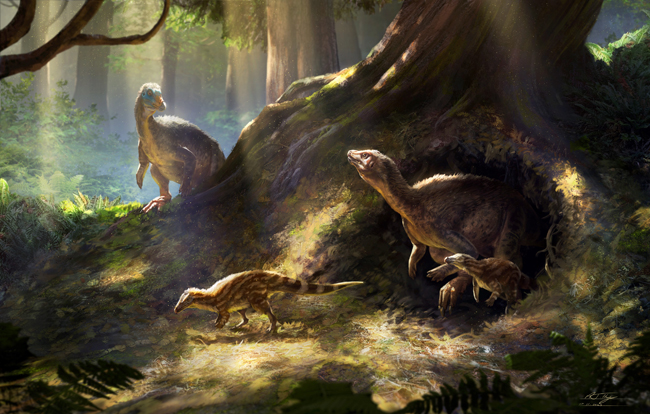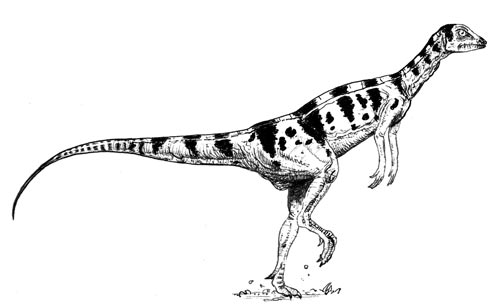A newly published scientific paper, examining the skull of a bird-hipped dinosaur (Thescelosaurus neglectus), suggests that this dinosaur had remarkable senses. CT scans of the skull suggest that this Late Cretaceous herbivore possessed a unique combination of traits and indicate that Thescelosaurus may have spent at least some of the time underground. The study is the first to link a specific suite of sensory abilities with dinosaur behaviour.
If you live alongside Tyrannosaurus rex, then having a burrow or den to hide in might prove to be an effective survival strategy.
Studying the Skull of “Willo”
The skull used in the study comes from “Willo”, which is part of the North Carolina Museum of Natural Sciences vertebrate collection. Thescelosaurus is a member of the Ornithischia. The genus was erected in 1913. It measured around four metres in length and weighed around 340 kilograms. That is about as heavy as a Jersey cow. In an ecosystem which included Triceratops, Edmontosaurus as well as T. rex, Thescelosaurus tends to be overlooked.

Picture credit: Anthony Hutchings
Thescelosaurus neglectus – “Wonderful, Overlooked Lizard”
The binomial scientific name of this dinosaur translates as “wonderful, overlooked lizard”. However, undeterred by this dinosaur’s lack of sharp teeth, dermal armour, crests or horns – traits associated with some of its contemporaries, Dr David Button (Bristol University) began studying Thescelosaurus.
Dr Button built up a detailed, three-dimensional model of the skull using multiple CT scans. The brain and the inner ear were reconstructed. This allowed the researchers to determine the size of the brain and to build up a picture of the dinosaur’s senses.
Dr Button commented:
“We found that the olfactory bulbs – the regions of the brain that process smell – were very well developed in Thescelosaurus. They were relatively larger than those of any other dinosaur we know of so far, and similar to those of living alligators, which can smell a drop of blood from miles away.”
Dr Button added:
“Thescelosaurus may have used its similarly powerful sense of smell to instead find buried plant foods like roots and tubers. It also had an unusually well-developed sense of balance, helping it to pinpoint its body position in 3D space, another trait often found in burrowing animals.”
There is More to Thescelosaurus
Co-author of the paper, published in Scientific Reports, Dr Lindsay Zanno (North Carolina Museum of Natural Sciences), stated:
“The irony is that palaeontologists generally think of these animals as pretty boring. When we first looked at our results we thought, yeah, this animal is plain as toast. But then we took a big step back and realised there was something unique about the combination of Willo’s sensory strengths and weaknesses.”

Picture credit: Everything Dinosaur
Limited Hearing
The scientists calculated that the hearing range of Thescelosaurus neglectus was extremely limited. It could only hear about 15% of the frequencies humans can detect, and between 4% to 7% of what dogs and cats can hear. In particular, T. neglectus was bad at hearing high-pitched sounds.
Dr Zanno explained:
“We found that Thescelosaurus heard low frequency sounds best, and that the range of frequencies it could hear overlaps with T. rex. This doesn’t tell us they were adapted to hearing T. rex vocalise, but it certainly didn’t hurt them to know when a major predator was tooling about in the area. More interesting to us was the fact that these particular deficiencies are often associated with animals that spend time underground.”
However, the researchers discovered that this dinosaur did have an excellent sense of smell.
T. neglectus may not have been particularly clever, not even for a dinosaur. It may have had limited hearing, but it had powerful arms and legs, a superb sense of balance and spatial awareness coupled with a keen sense of smell. These are all typical characteristics found in extant vertebrates that spend time underground or engage in digging behaviours.
Dr Button summarised the study:
“While we can’t say definitively that these animals lived part of their lives underground, we know that their ancestors did. This fact, together with their unique combination of sensory abilities, strongly suggests T. neglectus engaged in similar behaviours.”
Thescelosaurus neglectus – Not a “Boring” Dinosaur
Dr Zanno concluded:
“We still don’t know the sensory abilities of most dinosaurs. That makes it difficult to link these traits to specific lifestyles with confidence, but it also means there are plenty of cool discoveries to come. The idea that there might have been dinosaurs living under the feet of T. rex and Triceratops is fascinating. No matter what, we now know for certain that T. neglectus isn’t boring.”
Everything Dinosaur acknowledges the assistance of a media release from the University of Bristol in the compilation of this article.
The scientific paper: “Neuroanatomy of the late Cretaceous Thescelosaurus neglectus (Neornithischia: Thescelosauridae) reveals novel ecological specialisations within Dinosauria” by David Button and Lindsay Zanno published in Scientific Reports.
Visit the Everything Dinosaur website: The Everything Dinosaur Website.






Leave A Comment